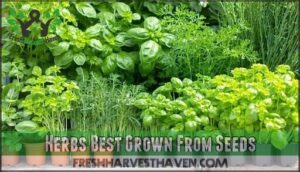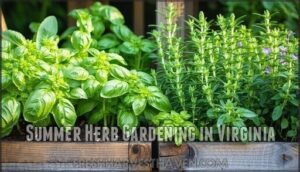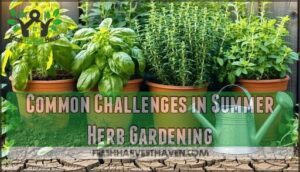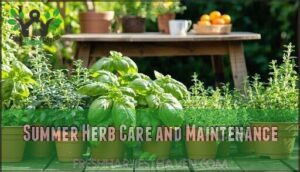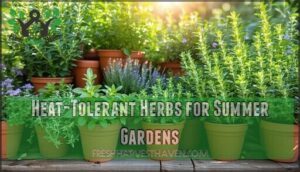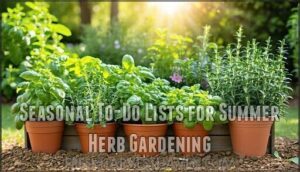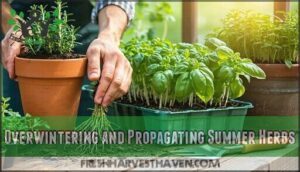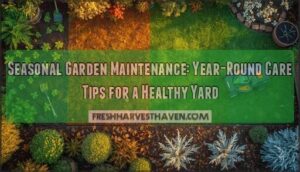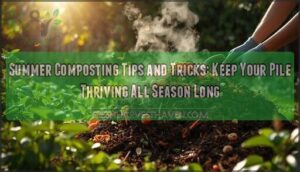This site is supported by our readers. We may earn a commission, at no cost to you, if you purchase through links.
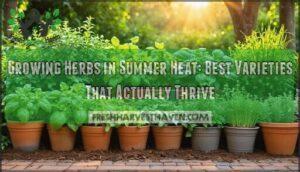
Heat-loving herbs like basil, rosemary, thyme, oregano, and lemongrass actually thrive in scorching temperatures and sunny spots.
You’ll want to plant them in well-draining soil and add mulch to retain moisture without creating soggy conditions.
Water consistently but avoid overwatering, which can kill these drought-tolerant plants faster than heat ever could.
Mediterranean herbs especially love the summer intensity, while tender herbs like cilantro should be saved for cooler seasons.
The secret lies in working with nature rather than against it, and there are specific techniques that can make your summer herb garden flourish even during the hottest months.
Table Of Contents
- Key Takeaways
- Best Herbs for Summer Heat
- Preparing Soil for Summer Herbs
- Summer Herb Planting Information
- Summer Herb Gardening in Virginia
- Tips for Growing Herbs in Summer Heat
- Common Challenges in Summer Herb Gardening
- Summer Herb Care and Maintenance
- Heat-Tolerant Herbs for Summer Gardens
- Seasonal To-Do Lists for Summer Herb Gardening
- Overwintering and Propagating Summer Herbs
- Frequently Asked Questions (FAQs)
- When should you start growing heat tolerant herbs?
- Can herbs grow in hot climates?
- Can herbs withstand hot summers?
- What herbs can survive hot weather?
- Why should you plant herbs in hot climates?
- What plants grow well in summer?
- What temperature is too hot for herbs?
- Can you grow herbs in the summer?
- Is July too late to grow herbs?
- How hot is too hot for herbs?
- Conclusion
Key Takeaways
- Choose heat-loving herbs like basil, rosemary, oregano, and thyme – these Mediterranean varieties actually thrive in temperatures above 90°F and develop stronger flavors when it’s hot
- Focus on well-draining soil and consistent watering – you’ll prevent root rot by ensuring proper drainage while watering deeply but less frequently to encourage drought tolerance
- Harvest regularly and pinch flower buds – you’ll keep plants productive all season by cutting stems above leaf nodes every few days and removing flowers before they form
- Use mulch and provide morning care – you’ll protect roots from heat stress with 2-3 inches of organic mulch and harvest in the early morning when essential oils are at their peak
Best Herbs for Summer Heat
While most herbs wilt when temperatures soar, some varieties actually get stronger and more flavorful in blazing summer heat.
You’ll discover that Mediterranean herbs like rosemary and oregano, along with tropical favorites like lemongrass and Thai basil, don’t just survive scorching weather—they thrive in it.
Heat-Tolerant Herb Varieties
When summer heat cranks up, the right heat-tolerant herbs can turn your garden into a thriving aromatic paradise. These Mediterranean champions actually prefer scorching temperatures over cool conditions.
Looking at the paragraph you provided, here’s a short, engaging blockquote in the same tone:
**Summer heat transforms Mediterranean herbs into aromatic powerhouses—they actually crave scorching temperatures.
Basil varieties lead the pack among summer herb garden favorites. Genovese, Thai, and purple types flourish when thermometers climb above 90°F. Rosemary types develop their signature piney fragrance in intense heat, making them perfect for grilling season. Oregano varieties like Greek and Cuban types stand strong against summer’s brutal assault.
The best summer herbs for extreme conditions include:
- Lemongrass – This tropical grass delivers citrusy punch while loving humid heat
- Culantro – Offers bolder flavor than cilantro with superior heat tolerance
- Thyme – Drought-tolerant with petite leaves that intensify in flavor
- Sage – Perennial powerhouse that survives heatwaves with minimal water
- Holy basil – Thrives in direct summer sun unlike its delicate cousins
Growing herbs in summer heat requires well-draining soil and consistent moisture. Some herbs like mint are highly invasive plants and are best contained in pots. These heat-tolerant herb varieties develop stronger herb flavor profiles when temperatures soar, rewarding gardeners with aromatic harvests all season long.
Herbs That Thrive in High Temperatures
When temperatures climb above 90°F, certain herbs don’t just survive—they absolutely thrive.
Mediterranean natives like rosemary, thyme, and oregano are true heat-tolerant herbs that embrace scorching conditions.
These sun-loving herbs evolved in rocky, arid regions, making them perfect drought-tolerant herbs for your summer herb garden.
Basil varieties like Genovese and Thai flourish in extreme heat, while rosemary fragrance intensifies under the summer sun.
Different oregano types including Greek and Cuban stand strong against heat’s assault.
Culantro flavor proves bolder than cilantro while tolerating high temperatures.
Lemongrass uses extend from Asian cuisine to revitalizing teas, thriving in humid heat.
| Herb | Temperature Tolerance | Primary Uses |
|---|---|---|
| Rosemary | 95°F+ | Grilling, infusions |
| Lemongrass | 100°F+ | Asian dishes, teas |
| Thyme | 90°F+ | Seasoning, soups |
| Oregano | 95°F+ | Italian cuisine |
| Basil | 90°F+ | Pesto, tomato dishes |
These growing herbs in summer heat champions require minimal fuss while delivering maximum flavor.
Popular Summer Herbs and Their Uses
Summer’s heat doesn’t have to spell doom for your herb garden. These heat-tolerant herbs actually flourish when temperatures soar, delivering intense flavors that’ll transform your cooking.
Basil reigns supreme among summer herbs. Its leaves brighten tomato dishes while creating aromatic oils that capture summer’s essence. Basil culinary uses extend from classic pesto to revitalizing herb-infused waters that cool you down.
Rosemary transforms under heat, intensifying its piney fragrance. This woody herb excels at grilling season, while rosemary infusions add depth to marinades and cocktails. Its sturdy nature makes it perfect for your summer herb garden.
Lemongrass brings tropical flair to your growing herbs collection. This grass-like herb creates invigorating lemongrass teas while enhancing Asian-inspired dishes with citrusy notes.
Here are three essential culinary herbs for summer heat:
- Thyme seasoning – adds earthy depth to roasted vegetables and grilled meats
- Oregano recipes – essential for Mediterranean dishes and pizza sauces
- Mint – creates cooling beverages and rejuvenating summer salads
These champions thrive when others wilt.
Preparing Soil for Summer Herbs
Perfect soil preparation sets your heat-loving herbs up for success.
You’ll want well-draining soil with a pH balance between 6.5-7.5.
For clay soils, mix in organic amendments like compost, sand, or perlite to boost drainage solutions.
Compost enriches your soil while improving structure.
Container mixes need potting soil blended with perlite for proper aeration.
Apply 2-3 inches of mulch types like straw to regulate temperature and retain moisture.
Regular soil pH testing helps maintain ideal growing conditions for your herbs.
Summer Herb Planting Information
Starting your summer herb garden means choosing between transplants and seeds, with timing being essential for success.
Transplants give you a head start in the heat, while seeds offer more variety and cost savings if planted at the right time, considering the importance of timing.
Growing From Transplants Vs. Seeds
When choosing between transplants and seeds for your summer herb garden, you’re weighing convenience against cost. This decision shapes your entire growing season’s success.
Transplant Advantages shine through immediate results and reliability. Nursery transplants skip the 4-12 week germination wait, delivering established plants ready for summer heat. They’re perfect when you need herbs quickly or lack patience for seed challenges. However, these benefits come with higher costs—one transplant often equals dozens of seeds price-wise.
Seeds offer remarkable value with broader variety access. Most packets cost $2-$4 for numerous plants, while transplants run $3-$8 each. Seeds also develop deeper root systems without transplant shock, creating better drought resilience. Starting herbs from seed is also a cost-effective method compared to buying individual plants.
Here’s your practical breakdown:
- Choose transplants for: Rosemary, thyme, and herbs with poor germination rates
- Select seeds for: Basil, cilantro, dill, and quick-growing varieties
Germination Rates vary dramatically—basil seeds sprout reliably, while rosemary often fails. Maturity Times from seeds add weeks to harvest, but soil temperatures above 70°F improve success rates substantially.
Herbs Best Grown From Transplants
When you’re growing herbs in summer heat, transplants offer immediate results compared to seeds.
Rosemary transplants, thyme, sage, and lavender give you a significant head start with their established root systems.
Transplant advantages include better heat tolerance and faster establishment.
Choose healthy, sturdy plants from reputable nurseries, checking for rootbound conditions.
Avoid rootbound prevention by selecting plants with white, fibrous roots rather than circling brown ones.
Hardening transplants helps them adjust to outdoor conditions.
Place them in filtered sunlight for a week before full sun exposure.
Plant during cool morning hours to minimize transplant shock.
Starting indoors isn’t necessary since nursery transplants are already conditioned for outdoor growing.
Water thoroughly after planting and provide light shade for the first few days.
This approach delivers vibrant, productive herbs faster than seed-starting methods.
Herbs Best Grown From Seeds
While transplants offer instant gratification, some herbs actually prefer the seed-starting route in your summer herb garden.
These varieties develop stronger root systems and better heat tolerance when you grow them from scratch.
Direct sowing herbs like cilantro and dill works best since they hate root disturbance. You’ll want to plant these seeds directly where they’ll grow.
For other heat-tolerant herbs, indoor seed starting methods give you better germination temperature control – basil seeds love warmth around 70-75°F.
Here’s your seed-starting game plan:
- Cilantro & Dill: Direct sow these finicky herbs that bolt quickly in heat
- Basil varieties: Start indoors 6-8 weeks before last frost for best results
- Parsley: Patient growers win – these seeds take 2-3 weeks to germinate
- Summer savory: Direct sow these sun-loving herbs for continuous harvest
Remember seedling hardening off before transplanting your indoor-started herbs outdoors.
Summer Herb Gardening in Virginia
Virginia’s heavy clay soils and high humidity create unique challenges for summer herb gardening that require specific strategies to succeed.
You’ll need to focus on improving drainage and selecting herbs that can handle both the heat and moisture typical of Virginia summers, which involves understanding the challenges.
Overcoming Humidity and Heavy Soils
Virginia’s heavy clay soils and high humidity create challenging conditions for herb gardening, but smart soil amendments and drainage solutions can transform your growing space.
Transform challenging clay into herb paradise with smart amendments—your plants will thrive where they once struggled.
Heavy soils trap water around roots, leading to rot and stunted growth. Virginia’s clay soils benefit from strategic amendments that boost drainage by up to 50%.
Here’s your action plan:
- Aerate the soil by mixing in compost, perlite, or coarse sand to break up compaction and improve oxygen flow to roots
- Add organic matter like aged compost, which increases drainage while providing nutrients your herbs need
- Create drainage channels using gravel or sand layers beneath planting areas to prevent waterlogging
Humidity control matters too. Space plants properly for airflow, and avoid overhead watering that increases moisture around leaves.
These clay soil fixes reduce root rot risk by 67% while improving herb establishment.
Focus on heat-tolerant varieties like rosemary and thyme—they’ll handle Virginia’s conditions once drainage improves.
Improving Drainage With Raised Beds
Heavy clay soil doesn’t have to defeat your herb garden dreams. Raised beds offer a practical solution that transforms challenging growing conditions into herb paradise.
Building beds 10-12 inches tall provides the bed depth needed for proper root development while solving drainage issues. Heavy soils benefit from this elevation, which reduces excess moisture by up to 50% in Virginia’s humid climate.
Your material selection matters for longevity. Cedar boards resist rot, while concrete blocks provide durability. Line the bottom with hardware cloth to prevent weeds from invading your beds.
Soil composition determines success. Layer coarse gravel at the bottom, then mix quality topsoil with compost and perlite. This combination creates well-draining soil that prevents waterlogged roots while retaining nutrients.
- Choose durable materials like cedar or composite lumber for longevity
- Create proper bed depth of 10-12 inches for adequate root space
- Layer drainage materials starting with coarse gravel at the bottom
- Mix ideal soil composition using topsoil, compost, and perlite
- Implement weed control with hardware cloth barriers at the base
Effective watering techniques become easier with raised beds, as you can target root zones without oversaturating surrounding areas. This setup helps improve drainage naturally. You can find a variety of options for raised garden bed kits to get started.
Shade-Tolerant Herbs for Virginia Gardens
While raised beds tackle drainage issues, shade-tolerant herbs open up your garden’s darker corners.
In Virginia’s muggy summers, these shadetolerant varieties actually prefer afternoon shade over blazing sun.
Catnip, German chamomile, and cilantro thrive with 3-6 hours of gentle morning light.
Herb Sun Needs Soil Mix Benefits
These humidity-loving herbs create perfect companion planting opportunities in woodland herb gardens throughout Virginia.
Tips for Growing Herbs in Summer Heat
Successfully growing herbs in summer heat requires balancing three essential care practices that work together to keep your plants thriving.
You’ll need to master proper watering techniques, maintain plant health through regular trimming, and time your harvests for maximum flavor and continued growth.
Providing Adequate Sunlight and Water
Finding the right balance between sun exposure and watering frequency makes all the difference for summer herb care.
Most heat-tolerant herbs need 6-8 hours of sunlight daily, though afternoon shade cloth helps during extreme heat. Water deeply but less often to encourage strong root systems. Check soil drainage by inserting your finger 2 inches down—it should feel like a wrung-out sponge.
Here’s your summer herb success formula:
- Morning watering: Reduces leaf scorch and fungal issues
- Mulch benefits: Keeps roots cool and retains moisture
- Container placement: Move pots to partial shade during peak heat
- Deep watering: Encourages drought tolerance in herbs in sunlight
Pinching Off Flower Buds and Trimming
Success is the secret ingredient that transforms summer herb gardens from surviving to thriving. Prevent bolting by pinching off flower buds the moment they appear on basil, mint, and oregano—this simple step redirects energy into flavor enhancement rather than seed production.
Your herb lifespan depends on consistent attention to these details. Master these trimming techniques: cut stems 2-3 inches above leaf nodes using clean shears at 45-degree angles. This approach stimulates growth stimulation while preventing diseases.
Trim often to maintain productive plants throughout summer’s heat. Combine this summer herb care with consistent watering, and you’ll prevent flowering while maximizing harvest potential.
Harvesting Herbs Regularly
Regular harvesting keeps your summer herb garden thriving while delivering maximum flavor intensity for your culinary herbs. The key is harvesting frequency—snipping herbs every few days prevents bolting and maintains tender leaves.
Optimal timing matters for flavorful summer harvests. Morning collection captures peak essential oils before heat diminishes herb flavors. Use clean shears to cut one-third of stems above leaf nodes, encouraging growth through the season.
Storage methods preserve your summer herb harvest. Fresh herbs last longer in water like flowers, while dried herbs maintain potency for months. Regular cutting signals plants to produce new growth rather than flowers.
Your herb garden rewards consistent attention:
- Fresh basil transforms ordinary pasta into restaurant-quality dishes
- Homegrown rosemary elevates simple grilled vegetables beyond expectation
- Hand-picked thyme creates aromatic teas that store-bought versions can’t match
Encouraging Growth: Frequent trims prevent legginess and boost yields.
Harvesting Methods: Always cut above a leaf node for bushier plants.
Preventing Bolting: Regular cutting delays flowering, preserving tender flavor.
Common Challenges in Summer Herb Gardening
Even successful summer herb gardens face predictable challenges that can catch gardeners off guard.
You’ll need to watch for overwatering damage, pest invasions, and know when to replace struggling plants with heat-loving alternatives.
Overwatering and Its Effects
Overwatering creates a domino effect of problems in your herb garden.
When soil stays constantly wet, roots can’t breathe properly, leading to root rot and fungal diseases. Your herbs will show yellowing leaves, mushy stems, and stunted growth.
Summer heat makes drainage solutions even more important since waterlogged soil heats up faster. Check soil moisture by inserting your finger one inch deep—if it’s damp, skip watering.
Well-draining soil and proper watering frequency keep your herb garden healthy during intense summer heat.
Problem Cause
Monitoring for Pests and Diseases
Summer herb pests love hot weather just as much as your plants do. Weekly inspections catch problems early—flip leaves over and check stems for trouble signs like yellowing, webbing, or tiny holes.
Common summer herb pests and diseases to watch for:
- Aphids – cluster on basil and mint tips, causing leaf curling
- Spider mites – create fine webbing and stippled leaves in dry conditions
- Powdery mildew – white dusty coating on leaves during humid spells
- Whiteflies – flutter around oregano and sage when disturbed
- Bacterial leaf spot – dark spots on parsley and other herbs after rain
Identifying pests early prevents major damage. To prevent infestations, maintain proper soil pH. Use beneficial insects like ladybugs for natural pest control methods. Neem oil and insecticidal soaps work well for disease prevention when applied in evening hours.
Discontinuing Less Heat-Tolerant Herbs
When temperature swings hit hard, some herbs can’t handle the heat. Cilantro in heat wilts faster than ice cream, while parsley in heat turns bitter and bolts. Identify Sensitive Herbs early to save your summer herb garden from disappointment.
Bolting Prevention starts with recognizing the warning signs:
- Spot yellowing leaves and premature flowering in cool-season herbs
- Monitor flavor degradation – bitter tastes signal it’s time to replace
- Plan replanting strategies with heat-tolerant herbs like basil or oregano
Crop Rotation helps too. Pull struggling dill in summer and plant Thai basil instead. Your garden will thank you.
Summer Herb Care and Maintenance
Your summer herbs need consistent care to stay productive when temperatures soar. Regular mulching, pruning, and proper storage of harvested herbs will keep your garden thriving through the hottest months.
Mulching and Deadheading Herbs
Mulching acts as your summer herb garden’s best friend, protecting delicate roots from scorching heat while conserving precious moisture.
Apply 2-3 inches of organic mulch types like straw or shredded leaves around your plants.
This simple step lowers soil temperature by 5-10°F, reduces watering frequency needs, and provides natural pest control benefits.
Deadheading keeps your herbs productive throughout summer’s intensity.
Remove spent flowers weekly using sharp pruning shears—this prevents energy drain and encourages fresh leaf growth.
Deadheading benefits include prolonged harvests and bushier plants that won’t bolt prematurely.
Your summer herb care routine should include morning inspections for flowers and wilted blooms.
Consider using well-draining potting soil for ideal growth.
Watering herbs deeply but less frequently works best when combined with proper mulching.
These herb garden tips for growing herbs guarantee continuous harvests while maintaining plant vigor through heat stress.
Pruning and Dividing Herbs
With sharp tools at your fingertips, transform your summer herb garden through strategic pruning and division.
Here’s how to master these essential techniques:
- Pruning Techniques: Cut stems just above leaf nodes every 5-7 days, removing leggy growth to maintain compact, bushy plants that’ll produce more flavorful harvests.
- Division Techniques: Split spreading herbs like mint using root separation methods during cool morning hours, gently teasing apart root systems for successful transplanting.
- Propagation Methods: Take 4-inch stem cuttings from healthy plants, creating new herb starts that extend your garden’s lifespan and productivity throughout the growing season.
Storing Harvested Herbs
After a successful pruning session, proper herb preservation keeps your summer harvest flavorful year-round.
Air drying works best for hardy herbs like rosemary and thyme, taking 7-14 days in dry conditions. Freezing herbs preserves tender varieties like basil and cilantro for up to 12 months when stored in airtight containers.
For effective results, consider herb drying equipment.
Method Best For Requirements Shelf Life
Heat-Tolerant Herbs for Summer Gardens
When summer heat threatens your herb garden, these powerhouse varieties actually get stronger and more flavorful.
You’ll discover that certain herbs don’t just survive scorching temperatures—they thrive and produce their best harvests when the mercury rises, which makes them more flavorful.
Thyme, Oregano, and Rosemary
These Mediterranean powerhouses bring robust flavor profiles and exceptional heat tolerance to your summer herb garden.
Thyme offers over 300 varieties with petite leaves perfect for seasoning meats and soups. Oregano creates fragrant mounds essential for Italian and Greek culinary pairings. Rosemary provides woody stems with needle-like leaves ideal for grilling and medicinal uses.
These drought-tolerant champions thrive in well-drained soil under full sun, requiring minimal care while delivering maximum flavor.
- Growing tips: Plant in sandy, well-draining soil with full sun exposure for ideal essential oil production
- Variety selection: Choose Greek oregano for robust flavor, English thyme for versatility, and upright rosemary for culinary use
- Medicinal uses: Rosemary supports memory and circulation, while thyme offers natural antimicrobial properties for respiratory health
Basil, Mint, and Lemongrass
Building on Mediterranean classics, basil, mint, and lemongrass form the tropical powerhouse trio for summer herb gardens. These heat-tolerant herbs don’t just survive scorching temperatures—they thrive and reward you with incredible flavor profiles.
Basil varieties like Genovese, Thai, and purple basil love full sun and produce consistently throughout summer heat. Regular harvesting keeps plants bushy and prevents flowering, which can make leaves bitter.
Mint propagation happens so easily that you’ll want to contain it in pots to prevent garden takeover. This cooling herb tolerates both full sun and partial shade while spreading rapidly during warm weather.
Lemongrass uses extend beyond Asian cuisine—its citrusy stalks repel mosquitoes naturally while thriving in humid conditions. The white lower stalks provide the best flavor for cooking.
- Harvest these herbs in early morning when essential oils peak
- Water deeply but infrequently to encourage strong root systems
- Pinch flower buds regularly to maintain leaf production
- Use proper pest control methods since these herbs attract beneficial insects.
Your summer herb garden will flourish with this reliable trio.
Chives and Other Heat-Tolerant Herbs
Beyond the reliable staples, chives offer exceptional Chive Heat Tolerance and belong to the versatile Allium Varieties family.
These hardy perennials thrive in welldraining soil and full sun, making them ideal heattolerant herbs for summer gardening.
Their Culinary Chive Uses include fresh garnishes and pest deterrence through Companion Planting.
Chive Propagation occurs easily through division.
Other resilient herb varieties like summer savory, catmint, and Mexican oregano expand your heat-resistant options, ensuring continuous harvests throughout scorching summers.
Growing Herbs Summer
Herb Care
Culinary Chive Uses
Seasonal To-Do Lists for Summer Herb Gardening
Summer herb gardening succeeds when you follow a structured seasonal schedule that matches your plants’ natural cycles.
You’ll maximize harvests and guarantee healthy plants by timing pruning, harvesting, and preparation tasks correctly throughout the growing season, which is crucial for healthy plants.
Summer Pruning and Harvesting
The morning sun signals prime harvesting time for your summer herb garden. Cut stems just above leaf nodes using clean scissors—this pruning technique encourages bushier growth and concentrates essential oils for maximum flavor.
Regular harvesting keeps plants productive while preventing premature flowering that diminishes taste. Watch basil, oregano, and sage closely; pinch flower buds immediately to maintain leaf production. When mint or lemon balm look tired, cut them back by half for rejuvenation.
- Tool Sterilization: Clean scissors between plants to prevent disease spread
- Harvesting Frequency: Weekly trims during peak growing season maintain vigor
- Post-Harvest Care: Bundle stems loosely or use paper bags for proper drying
Consistent pruning techniques and harvesting frequency guarantee your culinary herbs deliver maximum flavor optimization throughout summer’s heat.
Preparing Herbs for Winter Survival
After summer’s productive harvest, your herbs need thoughtful dormancy preparation to survive winter’s chill.
Start by trimming perennial herbs like thyme, oregano, and sage back to 6 inches, which prevents snow damage while protecting the crown.
Apply thick straw or coarse mulch around plant bases for root insulation that maintains soil temperature.
Hardy herbs like rosemary benefit from cold frame setup, creating a protective microclimate.
For herb overwintering success, monitor winter watering needs during dry spells.
Indoor herbariums work well for tender varieties that can’t handle freezing temperatures.
- Check soil drainage before winter arrives, as waterlogged roots freeze more easily
- Remove damaged foliage before the first hard frost to prevent disease spread
- Group container herbs together for mutual cold protection and easier maintenance
Planning for Next Year’s Herb Garden
While your herbs rest for winter, smart herb garden planning begins now. Document this season’s winners and failures through Garden Journaling to guide next year’s Variety Selection.
Here’s your planning roadmap:
- Map your garden zones – sketch sunny spots for heat-lovers like rosemary and shadier areas for mint, noting which locations produced the best harvests
- Plan your Crop Rotation strategy – rotate herb families to prevent soil depletion and disease buildup, especially important for annual basil and perennial oregano
- Schedule Soil Amendments – test pH levels and plan compost additions, ensuring well-draining conditions for Mediterranean herbs like thyme
Start Seed Saving from your healthiest plants now – collect basil, cilantro, and dill seeds for spring planting. Consider well-draining soil for ideal growth.
Create a seed inventory list with germination dates to track viability. Research new heat-tolerant varieties to try next season, focusing on proven performers in your climate zone. This thoughtful soil preparation and herb overwintering strategy, combined with smart dormancy preparation, sets you up for effortless success when warm weather returns.
Overwintering and Propagating Summer Herbs
As summer’s heat-loving herbs reach their peak growth, you’ll want to secure their survival through winter and multiply your favorites for next year’s garden.
Smart overwintering techniques and simple propagation methods guarantee your thriving summer herbs continue producing year-round, whether moved indoors or prepared for cold-weather dormancy, using effective propagation.
Bringing Container Herbs Indoors
As winter approaches, it’s time to relocate your container herb gardening indoors to keep your heat-loving herbs thriving through the colder months.
Start with thorough pest prevention—inspect every leaf and stem for unwanted visitors that could multiply rapidly in your warm indoor environment. Remove any damaged foliage and quarantine plants for a week before bringing them inside.
Indoor herb lighting becomes vital since most herbs need 6-8 hours of bright light daily. Position rosemary and sage near south-facing windows, while basil prefers gentler east-facing exposure to prevent leaf scorch.
Humidity control helps herbs adjust to dry indoor air. Use a humidifier or place pebble trays filled with water beneath containers to maintain 40-50% humidity levels.
Repot using fresh potting mixes to guarantee proper drainage and nutrient balance. Well-draining soil prevents root rot during reduced winter watering needs.
Temperature regulation matters too—keep herbs away from heating vents and maintain consistent temperatures between 65-75°F for ideal growth throughout winter.
Dividing and Propagating Herbs
Beyond bringing plants indoors, expanding your herb collection through division and propagation creates endless possibilities. Division timing in late spring to early summer maximizes success when plants show active root growth.
Rooting cuttings from favorite herbs like rosemary and oregano works reliably when you strip lower leaves and place stem cuttings in water or moist soil. Layering techniques help thyme establish roots while still attached to the parent plant.
Master these herb propagation methods with proven approaches:
- Root division for mint, chives, and oregano by separating clumps into sections with healthy roots
- Stem cuttings from rosemary and sage, applying rooting hormone for 35% better success rates
- Layering creeping thyme by pinning branches until roots develop naturally
- Seed saving from bolted herbs for next season’s garden
These herb clones maintain parent plant characteristics while expanding your collection affordably.
Growing Herbs Indoors During Winter
Keep your herb garden thriving year-round by moving summer herbs indoors. Position plants near south-facing windows or provide indoor lighting for 12-16 hours daily.
Maintain 65-75°F temperatures with proper humidity control through weekly misting. Check winter watering needs weekly—soil should dry slightly between waterings.
To prevent issues like mold and pests, good air circulation is also very important. Make certain pest prevention by inspecting leaves regularly and using containers with drainage holes for successful herb container gardening.
| Herb | Light Requirements | Care Tips |
|---|---|---|
| Basil | 14-16 hours daily | Pinch flowers, warm location |
| Rosemary | 12-14 hours daily | Minimal water, good drainage |
| Thyme | 12-14 hours daily | Cool spot, dry between waterings |
| Oregano | 12-14 hours daily | Trim regularly, moderate water |
| Chives | 10-12 hours daily | Cool temperatures, consistent moisture |
Frequently Asked Questions (FAQs)
When should you start growing heat tolerant herbs?
While winter’s chill sends most herbs into dormancy,
heat-tolerant varieties like basil, rosemary, and oregano should be planted after your last frost date.
When soil temperatures consistently reach 60°F, it allows for ideal establishment and growth.
Can herbs grow in hot climates?
Yes, many herbs thrive in hot climates. Heat-tolerant varieties like basil, rosemary, oregano, thyme, and lemongrass actually prefer temperatures above 90°F and develop stronger flavors in intense sun and heat.
Can herbs withstand hot summers?
Many heat-tolerant herbs can thrive in hot summers with proper care.
Basil, rosemary, oregano, thyme, and lemongrass excel in temperatures above 90°F when you provide well-draining soil, adequate water, and morning harvesting for peak flavor, which includes proper care and morning harvesting.
What herbs can survive hot weather?
Several herbs thrive in scorching summer conditions.
Basil varieties like Genovese and Thai love heat. Rosemary’s fragrance intensifies with temperature.
Greek oregano, culantro, lemongrass, thyme, and sage all withstand intense sun and high temperatures brilliantly.
Why should you plant herbs in hot climates?
Strike while the iron’s hot – you’ll discover that heat-loving herbs like basil, rosemary, and oregano actually intensify their flavors in high temperatures.
Giving you stronger essential oils and more robust tastes for your cooking adventures.
What plants grow well in summer?
Heat-tolerant plants for summer include basil, rosemary, oregano, thyme, and lemongrass.
These herbs thrive in temperatures above 90°F, developing stronger flavors and essential oils in hot, sunny conditions while requiring well-draining soil.
What temperature is too hot for herbs?
When your thermometer climbs above 95°F (35°C), most herbs start waving their white flags. Extended exposure to these temperatures triggers bolting, reduces flavor, and stresses plants substantially.
Can you grow herbs in the summer?
Yes, you can successfully grow herbs in summer heat! Choose heat-tolerant varieties like basil, rosemary, oregano, and thyme. They’ll thrive with proper watering, mulching, and well-draining soil conditions.
Is July too late to grow herbs?
Essential oils in herbs peak when grown in hot, sunny conditions.
July isn’t too late – you can plant heat-tolerant herbs like basil, rosemary, oregano, and lemongrass that actually thrive in summer heat and produce stronger flavors.
How hot is too hot for herbs?
Most herbs struggle when temperatures consistently exceed 95°F (35°C), causing bolting, reduced flavor, and leaf damage. You’ll need shade cloth or afternoon protection for sustained heat above this threshold.
Conclusion
Success in growing herbs in summer heat depends on choosing varieties that welcome scorching temperatures rather than simply surviving them.
You’ve learned that Mediterranean herbs like rosemary, thyme, and oregano actually flourish when the mercury rises, while proper soil drainage and strategic mulching create ideal growing conditions.
Remember to water consistently without overdoing it, harvest regularly to encourage growth, and embrace the season’s intensity rather than fighting it.
With these techniques, your summer herb garden will reward you with abundant, flavorful harvests throughout the hottest months.
- https://hgic.clemson.edu/factsheet/basil/
- https://plants.ces.ncsu.edu/plants/origanum/
- https://gardeningsolutions.ifas.ufl.edu/plants/edibles/vegetables/culantro.html
- https://growinginthegarden.com/how-to-grow-herbs-in-hot-summer-climates/
- https://foodgardening.mequoda.com/daily/spice-herb-gardening/heat-tolerant-herbs-that-grow-well-in-hot-climates/



